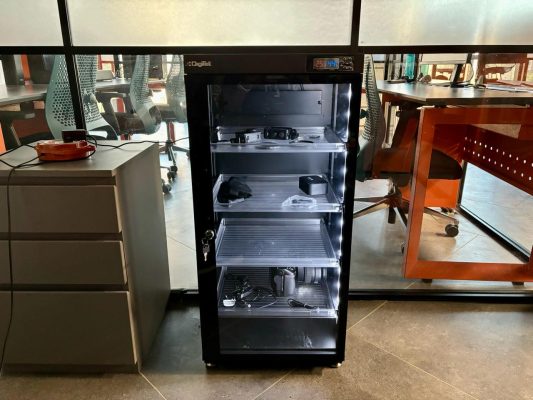If you have invested in expensive cameras and camera equipment, it is important to take extra care to ensure their longevity. Keeping them in a home environment can lead to the equipment slowly degrading over time, often requiring costly servicing. Fortunately, we have found an excellent product that can help you safeguard all your expensive cameras and equipment.
BUILD & DESIGN
The Digitek DS-130S Dry cabinet is an excellent storage solution for your valuable camera equipment. Its unique design resembles a refrigerator, with a transparent see-through front that lets you view your equipment without opening the cabinet. The cabinet is built of sturdy metal and weighs approximately 22 kg, making it a durable and long-lasting storage option for your camera gear.
The Digitek Dry cabinet comes in various sizes, depending on your equipment storage needs. You can choose the one that best suits your needs, whether you have a small collection of equipment or a large one. Its robust build quality makes it one of the safest dry boxes available. The DS-130S cabinet has four racks to store your equipment: cameras, lenses, memory cards, and hard drives. The racks are adjustable, so you can customize them to fit your specific equipment. The cabinet also features a digital display that shows the current humidity level and the temperature inside the cabinet. This helps you keep your equipment safe from moisture damage, which can cause irreversible damage to your camera gear.
FEATURES
Digitek Dry Cabinet is an advanced storage solution that provides a highly effective way to maintain the optimal temperature and humidity levels necessary to protect your valuable items from potential damage caused by moisture, mildew, moth, rust, dust, mould, fungus, oxidation, and other harmful elements. The cabinet utilizes the latest thermoelectric cooling technology that is quick, quiet, and heatless, making it an ideal choice for storing temperature-sensitive items like camera lenses.
In addition, the cabinet features a highly accurate humidity sensor that provides precise humidity control with a ±5% difference, which ensures that the humidity levels inside the cabinet remain at the desired level. You can easily adjust the relative humidity level inside the cabinet to anywhere between 25% and 60%, providing complete control over the storage environment. What’s more, as soon as the cabinet is powered on, it instantly starts dehumidifying, ensuring that your stored items remain safe and protected at all times. The cabinet’s advanced storage system also comes with a built-in hygrometer, which measures the current humidity levels inside the cabinet, allowing you to monitor the storage conditions easily.
Also read: Realme 12 Pro Review
VERDICT
The Digitek Dry Cabinet DS-130S is an excellent investment for anyone who owns expensive camera equipment and wants to ensure its cameras and equipment longevity. Its robust build quality and dehumidifying system make it one of the safest and most effective dry boxes available. The cabinet’s ability to regulate temperature and humidity levels using the latest thermoelectric cooling technology provides an ideal environment for storing temperature-sensitive items like camera lenses. Overall, the Digitek Dry Cabinet is a reliable and efficient storage solution that can safeguard your expensive camera equipment and help you avoid costly servicing in the long run.
Rating –
